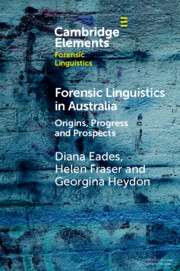Element contents
Forensic Linguistics in Australia
Published online by Cambridge University Press: 23 May 2023
Summary
Keywords
- Type
- Element
- Information
- Series: Elements in Forensic LinguisticsOnline ISBN: 9781009168090Publisher: Cambridge University PressPrint publication: 22 June 2023
References
- 13
- Cited by

